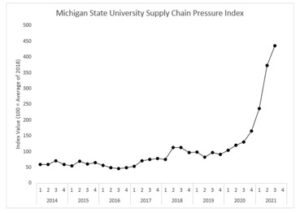What’s the outlook for inflation and supply chain relief in 2022? (Jason Miller Blog #3)
What’s in store for 2022?
Many analysts are asking this question – as they weigh off the good news from earnings season, against the warnings of the Fed that inflation will result in increased interest rates. However, one thing I don’t hear a lot of people talk about is the impact that clogged supply chains has on all of these outcomes – earnings, inflation, and revenue. (By the way, I’ve been talking about the role of inflation due to supply chain shortages since last August). For one thing, it’s hard to earn revenue when you don’t have product. We ordered a fridge last August, paid for it – and just got a notice that delivery has been pushed out to July! When products don’t show up – consumers start canceling orders…as I’m thinking of doing. I think it’s also fair to say that the supply chain problems are unlikely to be fixed in 2022 – although I keep hearing from pundits that “its getting better”. I don’t think it’s getting better – I think it’s likely to even get worse.
As a result, I am also of the opinion that the supply chain pressures will continue for much of 2022, which could further dampen production in many factories, and lead to continued reduced capacity. This is based on some recent collaborative work with Professor Jason Miller from Michigan State University, who developed a new supply chain pressures index, which was based on a post from the Cleveland Fed[1], going back to Q1 2004. Miller used the index which compiles the reasons manufacturing plants in the US gave for operating below full capacity on the Quarterly Survey of Plant Capacity Utilization from the Census Bureau. The Census uses a large stratified random sample of ~7,500 plants each quarter, far more than that respond to the PMI data in any one country (The sample is stratified, whereas PMI data are known to be skewed towards large firms). The index consists of a checklist of reasons for not operating at full capacity. The items “logistics/transportation constraints” and “insufficient supply of materials” fall very well under the domain of supply chain pressure.

There are several features of the index:
[1]: This index shows levels, not momentum. Policy is more concerned about levels of a series. The index has shown an unprecedented rise, especially between Q1 2021 and Q2 2021. With 2018 as a baseline, supply chain pressure is up ~337% as of Q3 2021. This is clearly indicative of a major set of labor and material shortages impacting multiple industries, including the beverage and aluminum beverage industries.
[2]: The MSU index increases in 2018 from 2017, which is consistent with strong manufacturing output as captured by the upward tick for durable goods excluding computers, communications equipment, and semiconductors. It also shows drops in 2016 (when output was weak) as well as in 2019 (which was soft relative to 2018). This speaks of broader validity, not just since COVID hit.
[3]: This index can be replicated at the 3-digit NAICS level, which is quite detailed (e.g., food manufacturing, beverage & tobacco, nonmetallic mineral products, rubber products, chemicals, primary metals, machinery, transportation equipment, furniture, etc.)
As shown above, the index is pretty bleak. Look at the problems we’ve had in 2020 – and then compare them to 2021. Then look at the trajectory of the 2021 index – and which way it is headed. It kind of reminds me of the Omicron spike, only it is unlikely to go down as rapidly as it occurred, but will likely remain very high. Moreover, the index suggests that such problems will continue to recur in 2022. One can observe that the level of pressures due to insufficient materials and insufficient labor has escalated dramatically in 2021 compared to the slight increased experienced in 2018. The level of disruption is unprecedented in the history of the world, and the disruptions in this case have continued throughout much of the first part of 2022. I believe that these disruptions and pressures will not diminish for some time, as the current set of problems related to labor shortages, port problems, COVID cases, and insufficient capital investment will continue through 2022. For this reason, I am not optimistic that we are going to see any relief to inflation and shortages, which may in turn hit revenue numbers… Sorry to be a Debbie Downer… but it is what it is!
[1] https://www.clevelandfed.org/en/newsroom-and-events/publications/economic-commentary/2021-economic-commentaries/ec-202117-semiconductor-shortages-vehicle-production-prices.aspx
[2] Note that this methodology is currently being documented in a research paper that will be submitted for peer review by Miller and Handfield.


